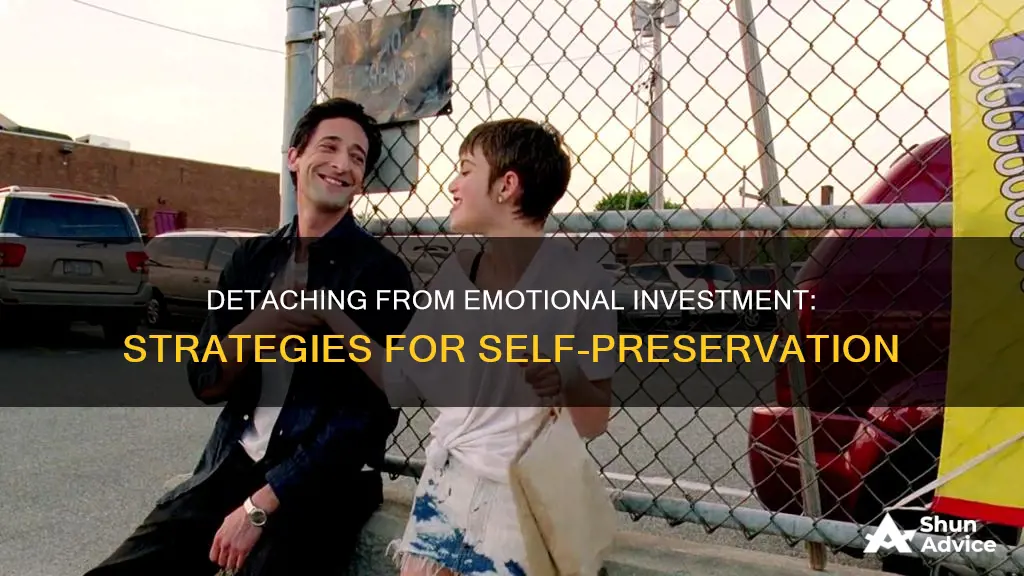
Emotional investment is a complex aspect of human relationships, with the potential to bring both joy and distress. While it can foster growth and happiness, it is crucial to recognise the fine line between healthy and unhealthy attachments. Unhealthy emotional investment can lead to excessive dependency, unmet expectations, and a loss of individual identity. To make yourself less emotionally invested in someone, it is important to understand the signs of unhealthy attachment, set personal boundaries, cultivate self-love, maintain your independence, and seek support when needed. By addressing these aspects, you can achieve a healthier balance in your relationships and ensure your emotional well-being.
What You'll Learn

Recognise signs of unhealthy attachment
Recognising signs of unhealthy attachment
Unhealthy attachments can be the result of a variety of factors, including early childhood experiences, relationship trauma, and poor emotional boundaries. Here are some signs that indicate you may be in an unhealthy emotional attachment:
- Significant jealousy or distrust: You spend a lot of time worrying about what your partner is doing, and you struggle to control your emotional response when they are not around. This suggests a lack of trust or an unhealthy dependence on their presence.
- Strong need for your partner's presence: You feel anxious or lost when your partner is not around, indicating that you have a hard time being independent and confident on your own.
- Excessive anger and frustration: You experience intense emotional reactions, such as anger and frustration, when your emotional boundaries are crossed. This can lead to conflicts and ruin a relationship if not addressed.
- Assuming your partner must meet all your emotional needs: In a healthy relationship, both partners are aware of their own and each other's emotional needs and can respect and meet those needs without neglecting their own. In an unhealthy attachment, one partner feels neglected and cannot stand when their needs are not being met, regardless of whether they are meeting their partner's needs.
- Lack of balance in the relationship: An unhealthy attachment is characterised by an imbalance where one partner makes everything about themselves or takes more than they give. This can lead to problems such as an inability to make basic decisions due to excessive dependence on the other person.
In addition to the above, other signs of unhealthy attachment include:
- Consistently oversharing or immersing yourself in the other person's life.
- Avoiding social interactions and struggling to form new or lasting relationships.
- Excessively worrying about how others perceive you and seeking constant approval.
- Struggling to ask for help and relying on others for validation.
- Neglecting your basic needs to prioritise someone else's needs.
- Feeling unworthy of love, a constant fear of abandonment, and difficulty trusting others.
- Difficulty expressing your feelings and maintaining emotional boundaries.
- Losing your sense of self and changing your habits, interests, and behaviours to align with your partner's.
- Experiencing intense negative emotions, such as hurt, anxiety, or depression, due to a disruption in your perception of yourself caused by conflict or disagreement.
Visualizing Your Investment Portfolio: A Graphical Guide
You may want to see also

Set personal boundaries
Setting personal boundaries is a crucial aspect of fostering emotional independence and maintaining healthy relationships. Here are some steps to help you set personal boundaries and reduce emotional investment in someone:
Understand the Different Types of Boundaries:
Firstly, it's important to recognize the different types of boundaries that exist in relationships. These include emotional, intellectual, physical, sexual, time, communication, and material boundaries.
- Emotional boundaries protect each partner's right to their own thoughts, feelings, and values without belittling, ridiculing, or invalidating their emotions.
- Intellectual boundaries protect each partner's thoughts and opinions, allowing them to agree to disagree while respecting each other's perspectives.
- Physical boundaries involve personal space and preferences around physical touch and physical needs such as food, rest, and health.
- Sexual boundaries include needs and limitations related to sexual interactions, such as the types of contact and contexts in which intimacy is comfortable.
- Time boundaries involve respecting each other's time and setting limits on how often you see each other, ensuring you don't feel obligated to spend all your time together.
- Communication boundaries are rules set to manage conflicts effectively, such as no name-calling or bringing up past arguments.
- Material boundaries are related to personal possessions and finances, and each partner can decide the degree to which they want to share these aspects.
Identify Your Boundaries:
Before conveying your boundaries to someone else, it's essential to understand your own boundaries. Take time to self-reflect and identify your personal boundaries in each of the categories mentioned above. Ask yourself what behaviours you find acceptable and unacceptable in each area.
Communicate Your Boundaries Clearly:
Once you know your boundaries, it's vital to communicate them openly, honestly, and directly to your partner. Be specific about your needs, expectations, and limitations. Ensure your partner listens attentively and understands your boundaries. It's important to have these conversations early in a relationship to minimize conflict, resentment, and anxiety.
Maintain Your Boundaries:
Sticking to your boundaries is crucial for your emotional well-being. If your partner does something that makes you uncomfortable or crosses a line, speak up and let them know. It's important to point out these instances and reinforce your boundaries to ensure they are respected.
Understand Permeable Boundaries:
While maintaining your boundaries is essential, it's also important to understand that healthy boundaries are permeable. This means that, at times, a person may cross a boundary, but it's your decision to bend a particular boundary when you feel it's appropriate.
Act with Self-Respect:
Remember that setting boundaries is about showing respect to yourself and your needs. Ensure that you act like someone who deserves respect and avoid sending signals that you come second in the relationship. For example, pay attention to dynamics like always adjusting your schedule to accommodate your partner or always being served second during dinner.
By setting and maintaining personal boundaries, you can effectively manage your emotional investment in someone and foster a healthier dynamic.
Investing in India: A Guide for NRIs in America
You may want to see also

Focus on self-love
Focusing on self-love is a crucial aspect of reducing emotional investment in someone. Here are some strategies to help you cultivate self-love and, in turn, lessen your emotional attachment to others:
Get to Know Your Emotions
Journaling is a powerful tool for self-discovery. By writing down your thoughts and feelings, you can gain a deeper understanding of your emotions and learn how to best care for yourself. Acknowledge and accept all your emotions, even the uncomfortable ones. This process will help you identify what triggers certain feelings and enable you to address the root causes.
Create a Mood-Boosting Playlist
Music has the power to influence your mood and emotions. Curate a playlist of songs that motivate, calm, or uplift you. When you're feeling down or overwhelmed, turn to this playlist for a quick boost of self-love and positivity.
Do What's Meaningful to You
Identify your values and make decisions that align with them. Spend time reflecting on what truly matters to you, whether it's compassion, creativity, humour, friendship, or something else entirely. Then, take action and engage in activities that embody these values. For example, if you value compassion, consider volunteering, or if travel excites you, plan a trip.
Create a Safe Space
Designate a safe zone where you can retreat and focus solely on your needs and emotions. This could be your bedroom, a peaceful corner, or even your car. Fill this space with things that bring you comfort and peace, such as candles, soft music, or anything that helps you relax.
Learn to Say No
Setting boundaries is an essential act of self-love. Recognize your limits and communicate them clearly to others. Be mindful of your energy levels and commitments. Don't overextend yourself—it's okay to say no to preserve your energy and well-being.
Practice Positive Self-Talk
The way you speak to yourself matters. Make a conscious effort to speak kindly to yourself and offer words of encouragement. Look at yourself in the mirror and name something you're grateful for. Challenge negative thoughts and replace them with positive affirmations that emphasize your strengths and worth.
Embrace Your Uniqueness
Celebrate what makes you unique. Make a list of your strengths, quirks, and interests. Instead of comparing yourself to others, recognize that your individuality enriches the world. Express yourself authentically and engage in activities that align with your passions and values.
Practice Gratitude for Your Body
Instead of focusing on flaws or societal ideals, cultivate gratitude for your body's capabilities and functions. Keep a gratitude journal specifically for your physical self, noting three things you appreciate about your body each day. Surround yourself with body-positive influences and actively challenge negative thoughts about your body.
Set and Enforce Healthy Boundaries
Boundaries are crucial for self-love and self-preservation. Reflect on your personal and emotional boundaries, identifying situations or relationships that drain your energy. Communicate your needs assertively and don't be afraid to say no or create distance when necessary. Surround yourself with people who respect and support these boundaries.
Prioritize Self-Compassion
Treat yourself with kindness and compassion, especially during moments of self-doubt or failure. Acknowledge that everyone makes mistakes, and offer yourself words of encouragement. Practice self-compassionate self-talk by challenging negative thoughts and replacing them with nurturing statements. Remember, self-compassion is a sign of strength and resilience.
Nurture Positive Self-Talk and Affirmations
Consciously choose uplifting and empowering language to reshape your internal dialogue. Identify areas of self-criticism and actively replace negative statements with positive affirmations. Create personalized affirmations that resonate with your goals and repeat them regularly as part of your daily routine. Surround yourself with positive influences, whether through supportive friends or uplifting literature.
Understanding Client Needs: An Investment Manager's Guide
You may want to see also

Maintain your independence
Maintaining your independence is a crucial aspect of fostering healthy relationships and ensuring your emotional well-being. Here are some detailed strategies to help you maintain your independence and reduce emotional investment in someone:
- Pursue your interests, hobbies, and social life: Engage in activities that you are passionate about and enjoy. Cultivate a rich and fulfilling life outside of your relationships. This will help you avoid becoming overly dependent on another person for your happiness and sense of identity.
- Set personal boundaries: Determine what behaviours and treatments you find acceptable and communicate your needs clearly to the other person. Healthy boundaries are essential for maintaining your independence and ensuring your emotional well-being.
- Focus on self-love and appreciation: Practise self-compassion and remind yourself of your worth. Engage in activities that make you feel good about yourself and boost your self-esteem. This will help you avoid seeking validation and approval from others.
- Limit contact if necessary: If your emotional attachment is causing distress, consider reducing the frequency of your interactions. This doesn't mean cutting the person off completely but creating a healthy distance to manage your emotions effectively.
- Reflect on past patterns: Take time to reflect on your past relationships and attachment patterns. Identify any recurring behaviours or unhealthy dynamics that may be contributing to your current situation. This self-awareness will help you make more informed choices in the future.
- Develop a sense of comfort with solitude: Spending time alone and enjoying your own company can reduce the fear of loneliness that often underlies emotional attachment. Discover activities that you can enjoy solo and embrace the peace and freedom that comes with being comfortable on your own.
- Understand the difference between love and attachment: Educate yourself about the distinctions between healthy love and emotional attachment. Love is mutual, respectful, and freeing, while attachment can feel needy and confining. Recognising these differences will help you navigate your relationships in a healthier manner.
Smart Strategies to Turn $100K into $1 Million
You may want to see also

Limit contact
Limiting contact with someone you're emotionally attached to can be challenging, but it's an important step towards fostering emotional independence and healthier relationships. Here are some detailed tips to help you limit contact effectively:
- Gradual reduction: While it may be tempting to cut off all contact, a more sustainable approach is to gradually reduce the frequency and depth of your interactions. This can mean less frequent texting, fewer phone calls, and less time spent together. This gradual approach allows for a smoother transition and helps to manage any feelings of withdrawal or longing.
- Set clear boundaries: Establish clear and concise boundaries that reflect your intention to limit contact. This may include not speaking to the person daily, not sharing intimate thoughts and feelings, and maintaining a healthy level of independence in your life. Communicate these boundaries to the other person and stick to them consistently.
- Avoid triggers: Identify and avoid triggers that remind you of the person. This could be certain places you associate with them, mutual friends, or even social media posts. If possible, eliminate these triggers from your environment to reduce constant reminders. If avoidance is not feasible, prepare a game plan to manage your emotions when encountering these triggers.
- Limit social media interaction: In today's digital age, it's essential to extend the concept of limiting contact to the online realm. Detach yourself from the person on social media by unfollowing or blocking them. This prevents you from constantly seeing their updates and reduces the temptation to reach out.
- Focus on other relationships: Invest time and energy in other relationships, such as friends and family. Strengthening these connections can provide a sense of belonging and support, reducing the intensity of your attachment to a single individual. It helps to fill the void that may be created by limiting contact with the person you're emotionally attached to.
- Redirect your attention: Redirect your focus away from the person by engaging in activities, pursuing personal goals, and practising self-care. Find hobbies and interests that bring you joy and fulfilment. By shifting your attention inward and prioritising your own needs, you can gradually detach from the other person.
Americans Taking Control: Investment Decisions and Independence
You may want to see also
Frequently asked questions
Emotional investment is when you focus your emotional energy on something or someone that's fulfilling for you. You might feel safe and comfortable expressing your feelings, respect your partner's boundaries, and feel accepted and valued in the relationship.
Unhealthy attachment can lead to a sense of dependency, where your happiness and self-worth are heavily tied to the presence or approval of another person. This can manifest as obsessing over the person, feeling anxious when they are not around, and neglecting your own needs and interests.
Define what behaviours you find acceptable and communicate your needs clearly to the other person. It's important to stick to these boundaries to maintain your emotional well-being.
Ensure that your happiness and identity are not entirely dependent on another person. Continue to pursue your own interests, hobbies, and social life, and practice self-love and self-compassion.







